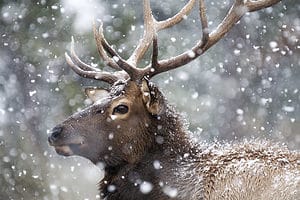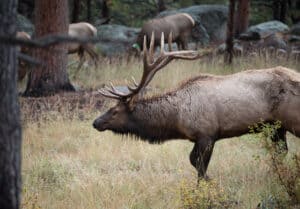Continue reading for our analysis...

The magnificent elk is one of the largest land-based animals in North America and the individuals in this footage were filmed at the amazing Yellowstone National Park. It is always a privilege to be able to get close to these amazing animals but you need to be aware of their power and treat them with respect.
As is clear from this video, elk have the ability to cause a lot of damage to humans and vehicles and it is not wise to make them angry!
Watch the Video Below
Rutting Season for Elk
The video here was shot during the rutting season and that is a big deal if you are an elk! It is the time of year when you find a mate and get to pass on your genes to the next generation which is, after all, the most important thing for any species.
Bull (male) elk behave differently during rutting season. They are competing for mating rights with harems of up to 20 females (cows). Rivals are intimidated in a number of ways and many are on display in this footage.
At the start, we see the bull elk bugling — this is the high-pitched screeching sound that is quite alarming at first. Bugling is very loud and piercing and can reach 4000 Hz although it can also be as low as 150 Hz. Elk bugle by blowing air from the opening between their vocal folds and directing it out through the nostrils.
What we don’t see here is the practice of digging holes to pee in and then rolling around in that pee so that they have a strong smell to attract the females. Yes, that is true!
However, what we do see is the males intimidating rivals with antler displays and wrestling. As the bulls attack the cars and trucks, they are essentially ‘showing off’ to the females that they are strong enough to defend them and protect them. That is what a female elk is looking for in a mate.
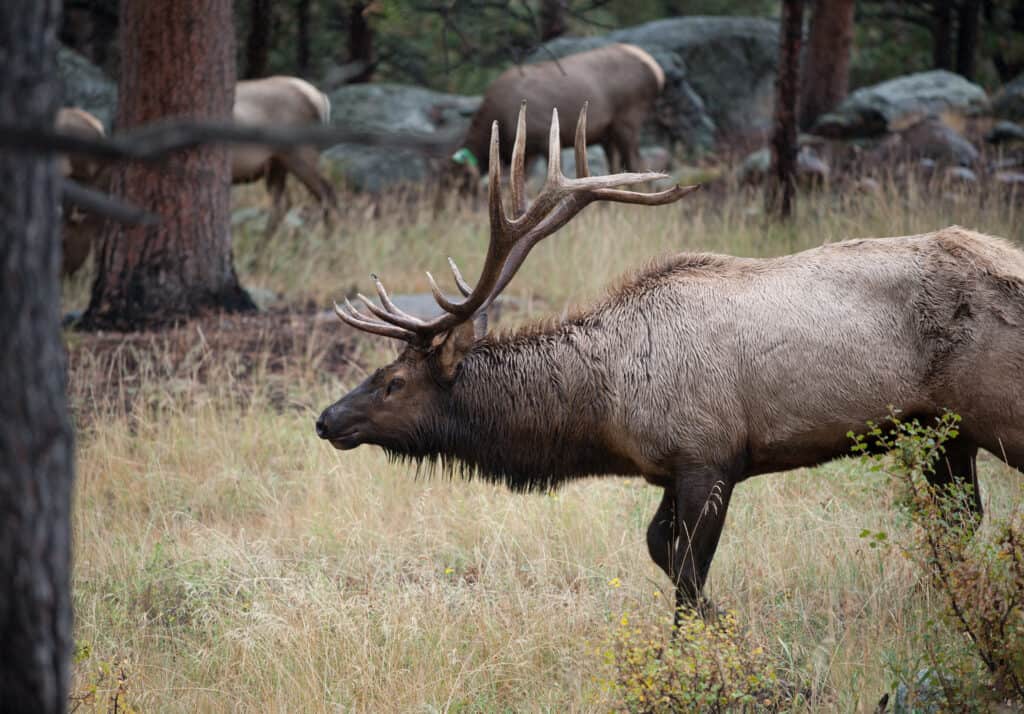
During the rutting season, male bull elks compete with other males in many ways for mating rights.
©Tony Campbell/Shutterstock.com
Where Do Elk Live?
Elk are an amazing animal, and at one point were the most widely distributed member of the deer family in North America. They could be found from the Atlantic to Pacific coasts and from Mexico all the way up to northern Alberta, with a population estimated as high as 10 million individuals. Unfortunately, their numbers dwindled drastically, and by the early 1900s, there were only 100,000 elk remaining.
Elks can be found across central Asia through Siberia and East Asia, and they also inhabit North America. Their habitat includes coastal forests, deciduous woodlands, boreal forests, mountainous areas, and grasslands. The type of habitat that Siberian elk prefer in Asia is similar to that of the Rocky Mountain subspecies in North America. Both seek out similarly lush environments where they can thrive best.

Elk can be found in North America and Central Asia through Siberia and East Asia.
©Bradley Wakoff/Shutterstock.com
Lifespan
Elk, also known as wapiti, are one of the largest species in the deer family and can live for over 20 years when kept in captivity. However, their average lifespan is much shorter in the wild due to a variety of factors such as predation, disease, hunting by humans, and environmental conditions.
On average, elk living in the wild will only survive from 10 to 13 years before succumbing to these various pressures. Despite their relatively short lifespan compared to other animals in the deer family, like moose, which can live up to 20 years in the wild, elk have been able to thrive across North America thanks largely to conservation efforts that have helped protect them from extinction.
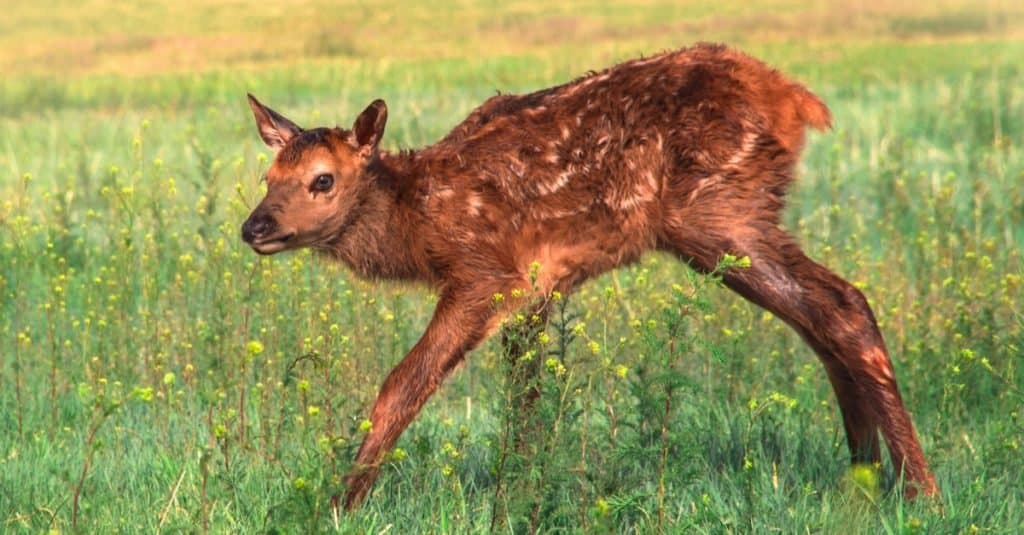
Elk live for 10-13 years in the wild.
©Karlie Butler/Shutterstock.com
Humans and Elk
Humans and elk have a close relationship. The visitors to the park are clearly fascinated by their behavior, and some people may be taking it a bit far by antagonizing the elk. However, they end up paying the price for this with some dented bodywork! Elk are powerful animals and can weigh up to 1,300 pounds, and they can run at up to 40 mph. Males can even jump 8 feet vertically in the air!
If you are not inside a strong vehicle, their antlers can cause serious injuries. They are made from bone and grow up to an inch a day, controlled by testosterone levels in the body. Elk are a hunting game species, and their antlers are used for artwork and furniture. Currently, the elk population is healthy and they are not endangered, so these males must be doing a great job!
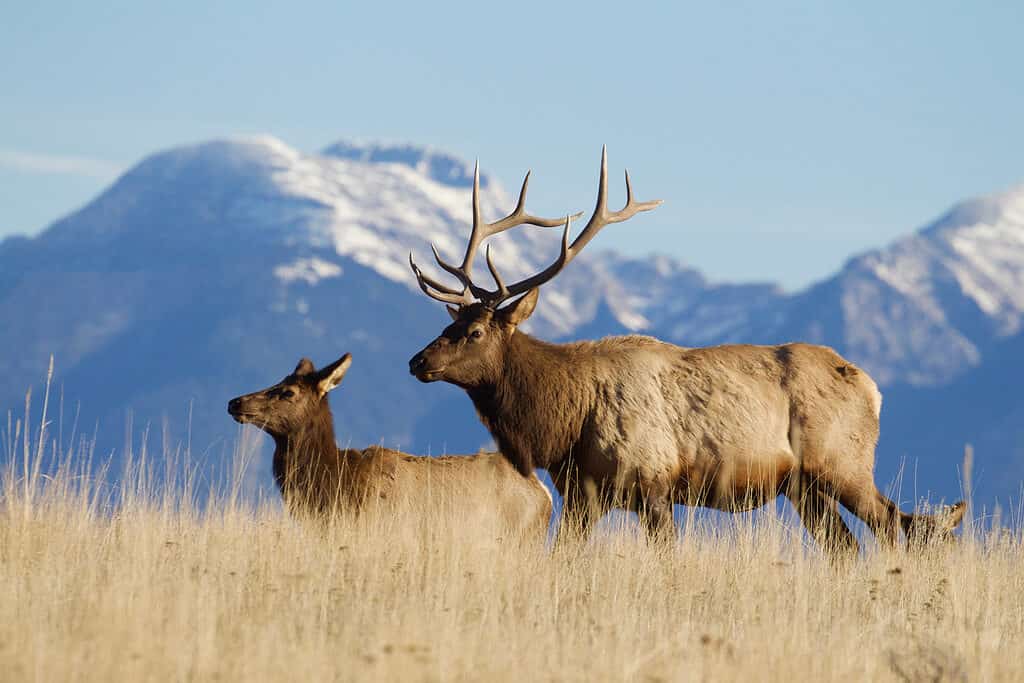
Elk are powerful animals and can weigh up to 1,300 pounds, and they can run at up to 40 mph.
©Tom Reichner/Shutterstock.com
Elk vs Moose: What is the Difference?
Elk and moose are both large members of the deer family found in North America, but there are some distinct differences between them. The most obvious difference is size. Elks have a slimmer build than moose and generally weigh less. Elk also tend to have lighter-colored fur that ranges from yellowish to reddish-brown, while the fur on a moose is usually darker brown or black.
Additionally, elk antlers typically fork into two separate branches after branching off of the main beam, while those of a moose branch out further with more points along them. Finally, male elk make a loud bugling sound during mating season, which can be heard for miles away. This same sound isn’t made by male moose. Instead, they grunt or bellow when communicating with one another.
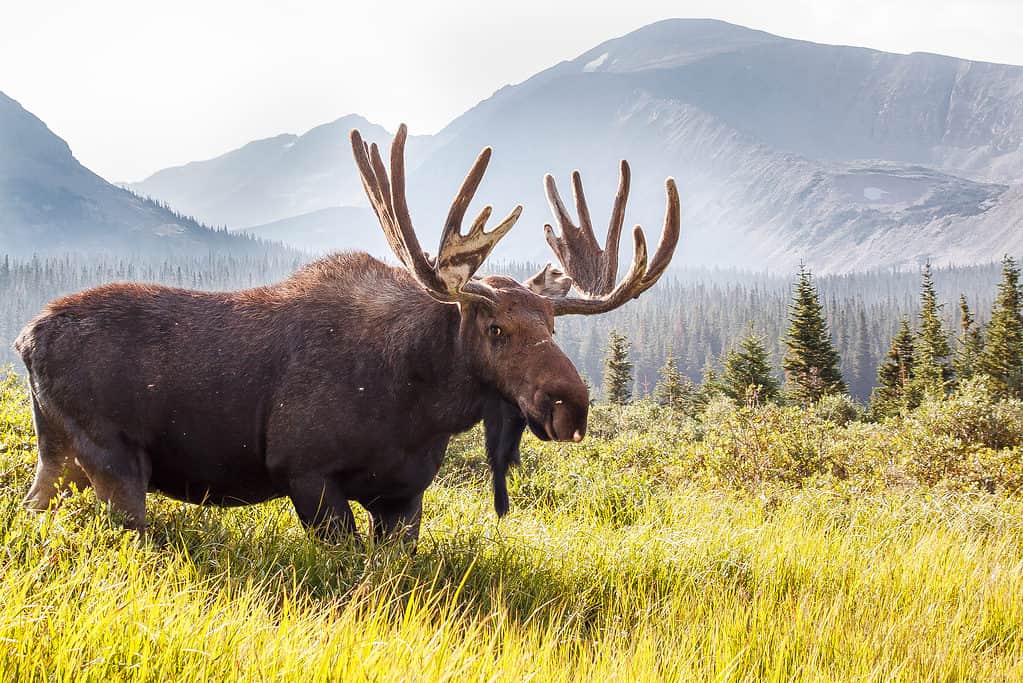
Moose are typically larger and heavier than elk.
©Michael Liggett/Shutterstock.com
Is it Normal for Elks to Ram Vehicles?
During rut or mating season, elks can turn extremely aggressive. They’ve been known to charge humans, cars, dogs, and anything else that may pose any type of threat.
It is recommended to stay at least 50 yards away from any elk because they can become highly unpredictable, especially during certain seasons.
Although ramming or attacking cars isn’t a normal, everyday activity for elk, it does happen, as you can see in this video.
Other Amazing Animal Videos You Might Like
It’s natural for many species of animals to become aggressive when they feel threatened or want to display their dominance like these elk. While the elk in Yellowstone National Park were roaming free and able to ram cars as a show of power, when the animal in the next video attacked, a layer of protective glass at a zoo stopped him from doing any damage — which was very fortunate for the people watching!
An adult male silverback is shown charging toward the man filming not once but twice. The first time the gorilla makes a sharp right turn before he reaches the edge of the enclosure, but the second time he charges he hurls himself hard at the glass — which instantly cracks! Luckily it stays intact, but it’s definitely enough to startle and scare the onlookers. Read more about the encounter here and see the action for yourself below.
Thank you for reading! Have some feedback for us? Contact the AZ Animals editorial team.




